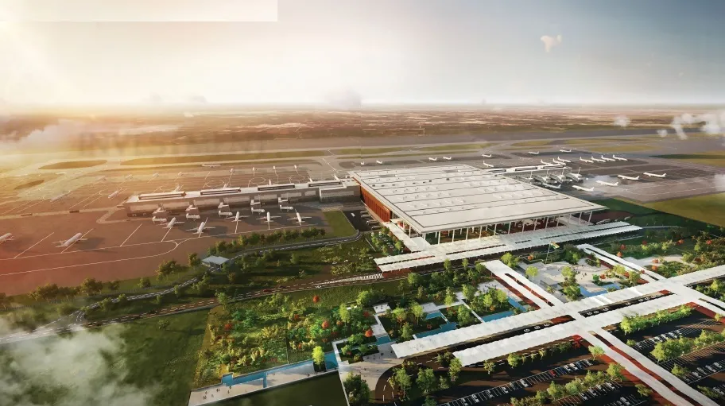Combining Indian warmth and hospitality with Swiss efficiency, Noida International will be the second airport for the National Capital Region of India, creating the country’s first metropolitan dual airport system.
The Indian civil aviation market is set to become the third largest, according to International Air Transport Association (IATA) figures, and is one of the fastest growing in the world, according to aviation analytics firm OAG. The latter’s latest Megahubs index, generated by comparing the number of scheduled connections to and from international flights with the number of destinations served from an airport, rates Delhi Airport and Mumbai at 24 and 44, respectively.
These positions have been strengthened thanks to new routes and increased flight frequencies, with OAG reporting scheduled airline capacity from India up almost 9% in 2024, with 240 million seats across domestic and international markets.
The country’s position as a leader in air travel looks set to strengthen, as the Aviation Ministry of India recently revealed its intention to build 200 additional airports by 2040 to serve the country’s increasing air passenger traffic numbers.
One of the first to open will be Noida International Airport (NIA), a greenfield airport now close to completion in Jewar, Noida. Scheduled to begin commercial operations in April 2025, it will be the second airport servicing the National Capital Region (NCR) of India, which encompasses all of Delhi and 24 districts from neighboring states Haryana, Uttar Pradesh (UP) and Rajasthan.

“It will have a strong, positive impact on industrial growth in the region”
Jan Wicki, NIA
“This will be the first time India has a dual airport system within one metropolitan area, and it will complement Delhi’s Indra Gandhi International Airport (IGIA), because the demands within the region are huge,” says Nicolas Schenk, chief development officer at Noida International Airport – Zurich Airport International AG (ZAIA). “You only need to look at the numbers of new aircraft being ordered by airlines like IndiGo and Air India to see that the region is underserved in terms of airport infrastructure.
“Its placement in Noida, which is on the other side of the NCR from IGIA, also means it captures its own catchment area,” he continues, “serving those people who are living in what is one of the fastest-growing urban areas in India.”
NIA won’t just benefit people traveling to the east of Delhi. It will also help businesses and support the community through new job opportunities. “For example, in terms of cargo to and from Noida’s industrial zone, their goods won’t have to travel through the whole of Delhi, saving time and money,” says Jan Wicki, VP of program management and operational readiness and airport transition (ORAT) at Noida International Airport. “We expect it will also have a strong, positive impact on industrial growth in the region.”
The introduction of a dual airport system has led to the need for airspace restructuring in the region. This is a major task and is being led by the Airports Authority of India (AAI).
“They’re doing a great job so far in developing the airspace to allow for unconstrained routes for both airports, which don’t compromise either IGIA or us in terms of arrival or departure procedures that would have an impact on our capacity,” says Wicki.
“We can serve a domestic or international flight from the same contact stand”
Jan Wicki, NIA
Swiss influence
The UP government awarded the NIA project to Yamuna International Airport Private Limited (YIAPL), a subsidiary of Zurich Airport International, in 2019, and construction of the new infrastructure has been underway for the last two-and-a-half years. At the time of writing, Noida’s instrument landing system (ILS) calibration flights have just been completed and the team behind the project are preparing the airport for operational readiness while the last of the construction is completed.
Swiss efficiency and Indian hospitality were key values in the airport’s design, ensuring that moving through the airport is as simple and smooth as possible, with rich experiences and commercial offerings for passengers.
The team looked at how passengers and airlines could maximize their use of the airport, which included minimizing aircraft ground time. With this in mind, it introduced the concept of mixed rotation on contact stands – a first in India, according to Schenk. “Basically, we’re building the terminal in a way that we can serve a domestic or international flight from the same contact stand,” explains Wicki. “This will help keep aircraft turnaround time down, as they won’t need to be towed to another stand if its inbound flight is domestic but its outbound is international.”
Wicki also says that Noida’s remote parking positions have been designed so that in the future aircraft will be able to taxi in and out themselves without the need for a pushback truck, which will also speed up turnaround time.
“On the hospitality side, we introduced a huge forecourt with a similar footprint to that of the terminal itself, where departing and arriving passengers, as well as airport employees, all come together and mingle,” reports Schenk. “Here we’re creating a kind of ‘destination’, with a real mix of food, beverage and retail offerings. Another example is after security control, where we’ve designed an 18 x 36m courtyard open to the sky for passengers to relax in.”
Strong foundations
Noida International has been designed to grow in line with its users. Its masterplan comprises four development phases, with the next expansion phase triggered whenever there is a need for additional capacity. This will be when the airport reaches around 80% of existing capacity.
Phase 1, featuring one runway and one terminal, will have the capacity to handle 12 million passengers a year. Phases 2 and 3 will support 30 million and 50 million respectively, while on completion of Phase 4, Noida will be able to manage up to 70 million travelers per year.

“A lot of modularity has been built in to the design of the airport so we can expand as we need to,” says Wicki. “We’ve also baked in flexibility, so we can convert some of the domestic area into international area in future, if the split between domestic and international passengers develops differently from what we’ve anticipated.”
In fact, there’s such demand for capacity in India right now that the team is already tendering for some of Phase 2’s development, starting with 10 additional apron stands. “Anticipated traffic tells us that within less than five years the terminal expansion will need to be initiated as well, adding another 18 million capacity, so we’ve started the planning and tendering for Phase 2 already. We have a clear plan going forward,” says Schenk.
Pandemic problems
Although everything seems to be running smoothly, this project hasn’t been without its challenges, the biggest being the fact that a large amount of the work took place during the pandemic.
“Within less than five years, the terminal expansion will need to be initiated, adding 18 million capacity”
Nicolas Schenk, NIA
“A greenfield airport is challenging enough as everything needs to be built from scratch, but we had to do much of our work during an international lockdown,” says Wicki. “This could be the first airport to be designed entirely from home offices,” he laughs, “as the majority of the project was completed remotely – we had design consultants from five countries working together via Microsoft Teams!”
“Although this project began back in 2019, June 2022 was the first time the whole design team met in person,” Schenk notes. “We thought the lockdown situation would be over after a couple of months so made the decision to kick off the process with the international design competition. We then had to decide what to do and chose to keep going full steam ahead. I think this paid off in the end, because as soon as travel was possible again, we were able to kick off the physical side of the project.”
NIA’s operational readiness program also began quite early, over a year ago, which has given Wicki and his colleagues a comfortable amount of time to bring everything together.
“We’ve been lucky to hire a lot of very talented people, but many of them haven’t worked with each other before and have come from other airports where things might have been done differently,” he says.
“Therefore, we’ve invested a lot of time in defining, aligning and writing down our processes, so that everyone has the same understanding and we can start training everyone according to how we want Noida to operate.
“I think we’re there now and we’re trialling our control centers already. Systems configurations are ongoing and we’re now hiring the last of the staff so we’re ready to activate all infrastructure next year.”
Going paperless
NIA is looking to provide an entirely paperless journey through its facility, in line with the industry-led Digi Yatra (digi journey) initiative, which was launched by India’s Ministry of Civil Aviation. This uses India’s ID card database to enable a biometric journey through the terminal.
“Basically, all our passenger touchpoints, from terminal entry, check-in and baggage drops through to security and boarding gates, will be biometrically enabled, so you can move through all these just using your face,” says the airport’s Jan Wicki.
“We’re looking to take things further and enable touchless and paperless operations when it comes to parking, too. Using license-plate recognition and QR-code payment we can entirely eliminate the need for a paper ticket.”
State-of-the-art security
Noida International Airport (NIA) will feature state-of-the-art security infrastructure, and its design incorporates crime prevention through environmental design (CPTED) principles.

“One of the key challenges in aviation security is the rapid evolution of aviation security technologies. However, as a greenfield project, NIA has the advantage of building strong security fundamentals from the ground up,” says Ajesh Verma, the airport’s head of security. “This allows us to integrate the latest advances right from the start.”
Cabin baggage will be screened remotely using an automated tray retrieval system (ATRS), with 13 security lanes in place during Phase 1. The airport will use an in-line hold baggage system, allowing continuous tracking throughout the journey, enhancing security.
Landside, terminal and airside will be under 24/7 CCTV surveillance, with selected cameras equipped with AI-based threat detection systems to provide real-time tracking and issue alerts when necessary. The fully automated security operations center (SOC) will operate on a unified dashboard, gathering inputs from the CCTV system, in addition to those from its perimeter intrusion detection system (PIDS) and access control systems (ACS).
Physical security systems conforming to the highest international crash standards – consisting of boom barriers, static and hydraulic bollards, tire killers and turnstiles – will be installed at critical points across the airport, while walk-through metal detectors and full-body scanners (to be finalized) will provide enhanced passenger screening at pre-embarkation security checkpoints.
“Additionally, the airport’s emergency control center will be equipped with advanced ICT systems to ensure quick, effective responses to any potential threats and crisis situations,” Verma notes.
He has also implemented comprehensive, role-based aviation security training programs, which cover regulatory requirements for threat-based detection and screening of restricted items.
Furthermore, third-party stakeholders, including concessionaires, ground handlers and external contractors, will also receive need-based security training “to ensure cohesive security operations across the airport”.
Sustainable airport operations in India

With India’s aviation industry experiencing remarkable growth, it’s important that sustainability remains front of mind. Noida International Airport has committed to an ambitious net zero emissions goal for 2030, which will be supported by the sustainable design and operations principles of the airport.
For example, NIA has already signed a purchase agreement for a partner to build an on-site solar farm and an off-site wind park, which will supply the airport’s energy.
“We will start with 56% of our energy coming from sustainable sources and then gradually, as we get to know our airport’s energy demands, we can optimize the overall system to get to 100%,” says NIA’s Nicolas Schenk.
“We’ve also implemented natural lighting in the terminal’s design wherever possible to minimize the use of energy for lighting. This reduces carbon emissions, plus I think natural lighting is more welcoming and relaxing for people traveling through the airport,” he adds.
“We will also be looking at things like optimizing our use of water and will of course be harvesting rainwater to use for flushing, cleaning and irrigation.”
While in no way linked, NIA’s sustainability goals support those set by the Airports Authority of India (AAI), which last year launched the Sustainable Green Airports Mission (SUGAM) to reduce the environmental impact of airport operations by promoting the use of more sustainable processes.
This article originally appeared in the January 2025 issue of Passenger Terminal World. To view the magazine in full, click here.


